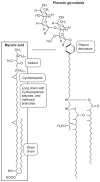Mycobacterium Tuberculosis in Spinal Tuberculosis
- PMID: 28243382
- PMCID: PMC5326722
- DOI: 10.4184/asj.2017.11.1.138
Mycobacterium Tuberculosis in Spinal Tuberculosis
Abstract
Even in an era of remarkable medical advances, there is an issue of why tuberculosis remains in the list of disastrous diseases, afflicting humans and causing suffering. There has not been a plausible answer to this, and it has been suggested that clinicians and medical scientists could presently not win the war against the tubercle bacilli. With regards to this issue, based on the authors' own clinical and research experiences, in this review, the available literature was revisited in order to address the raised questions and to provide recent information on characteristics of tubercle bacilli and possible ways to more effectively treat tuberculosis.
Keywords: Behavior; Cell envelops; Drug response; Morphology; Tissue pathology.
Conflict of interest statement
Conflict of Interest: No potential conflict of interest relevant to this article was reported.
Figures





References
-
- Strelkauskas AJ, Strelkauskas J, Moszyk-Strelkauskas D. Microbiology: a clinical approach. New York: Garland Science; 2010.
-
- Gladwin M, Trattler B. Clinical microbiology made ridiculously simple. Miami: MedMaster; 2009.
-
- Slonczewski J, Foster JW. Microbiology: an evolving science. New York: W.W. Norton; 2011.
Publication types
LinkOut - more resources
Full Text Sources
Other Literature Sources
Miscellaneous

